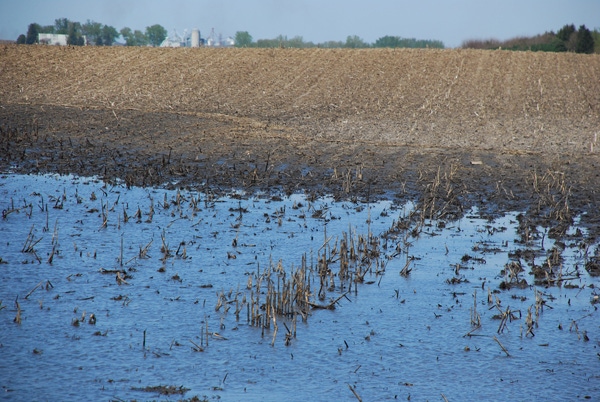May 31, 2013

Due to continuing wet weather, some farmers will not have planted all their corn by the final planting dates contained in their crop insurance policies. Once the final planting date has been reached, a farmer who has purchased the COMBO product (RP, RP with exclusion or YP) will have the option of taking a prevented planting payment. In many cases, taking the prevented planting payment will be an economically attractive alternative.
Contact Crop Insurance Agent
The following material lays out alternatives when faced with late planting and illustrates a spreadsheet for comparing alternatives. As will become apparent, prevented planting is complex. Farmers need to contact their crop insurance agent when considering taking prevented planting payments.
Of specific concern are rules that dictate the number of acres available for prevented planting. As a general guideline, the maximum acres eligible for prevented planting payments on corn equal the maximum acres of corn planted in the last four years, adjusted for acreage increases between 2012 and 2013, less corn acres planted in 2013. Each situation is specific and there are variations from the above guideline. Crop insurance agents can make sure farmers are eligible for prevented planting payments.
Final Planting Dates
A key date relative to prevented planting is the final planting date. In Illinois, the final date is May 31 for extreme southern counties and June 5 for all other counties.
Like what you're reading? Subscribe to CSD Extra and get the latest news right to your inbox!
Once the final planting date has been reached, farmers have three options:
Take a prevented planting payment. Prevented planting payments are available to holders of RP, RP with the harvest price exclusion and YP. Prevented planting is not available for Group Risk Plan or Group Risk Income Plan polices. To take a prevented planting payment, plantings have to be prevented for insurable causes.
Plant corn after the final planting date.
Plant soybeans after the final planting date.
Take a Prevented Planting Payment
Unless a 65% or 70% buy up option has been selected at crop insurance signup, prevented planting payments equal 60% of the springtime guarantee. As an example, take an RP policy with an 80% coverage level having a 180-bu./acre guarantee yield. The 2013 projected price $5.65. This policy has a guarantee of $814/acre (80% coverage level x 180-bu. guarantee yield x $5.65 projected price). In this case, the prevented planting payment is $488/acre ($814 x 0.60). The 65% and 70% buy up options would replace the 60% factor in the payment calculation with 65% and 70%, respectively, resulting in higher payments.
Even though RP's guarantee equals the higher of the projected or harvest price, the prevented planting payment is based only on the projected price.
If a prevented planting payment is taken, a farmer cannot plant another crop during the late planting period consisting of 25 following the final planting date. Planting another crop during this 25 day period will eliminate the prevented planting payment.
After 25 days, another crop can be planted, usually resulting in a reduction in prevented plating payments to 35% of the original amount. In double-crop situations, obtaining the entire prevented planting payments while planting soybeans may be possible.
Planting After Final Planting Date
Planting Corn after the Final Planting Date
Famers can still plant corn after the final planting date. If they do, they will not receive a prevented planting payment. Also, the guarantee will be reduced by 1%/day for each day after the final planting date up to 25 days after the final planting date. After 25 days, the guarantee will be 60% of the original guarantee.
To illustrate, take a farmer having an RP policy with a minimum guarantee of $814/acre from the above example. Note that this is a minimum guarantee, as the guarantee can increase if the harvest price is above the projected price. If the harvest price is above the projected price, the higher harvest price is used in calculating guarantees. Assume this farmer is in a county with a final planting date of June 5. If corn is planted on or before June 5, the minimum guarantee is $814/acre. A 1% reduction occurs if planting takes place on June 6 and the guarantee is $807 ($814 x (1-.01)). Planting on June 7 results in a 2% reduction, or $799 ($814 x (1-.02)). After 25 days, the guarantee is 60% of the original, or $488/acre ($814 x .60).
Plant Soybeans after the Corn Final Planting Date
Soybeans can be planted on acres intended to be planted to corn. In this case, there will not be a prevented planting payment for corn. The soybeans will be insured if the farmer has elected to insure soybeans. This will be a normal soybean policy, unless soybeans are planted after the final planting date for soybeans (in mid-June). In this case, the guarantee is reduced, similar to that in the above example for corn.
Read more from the University of Illinois about the economics of prevented planting.
You might also like:
Corn, Soybean Seedling Survival in Waterlogged Soils
You May Also Like




